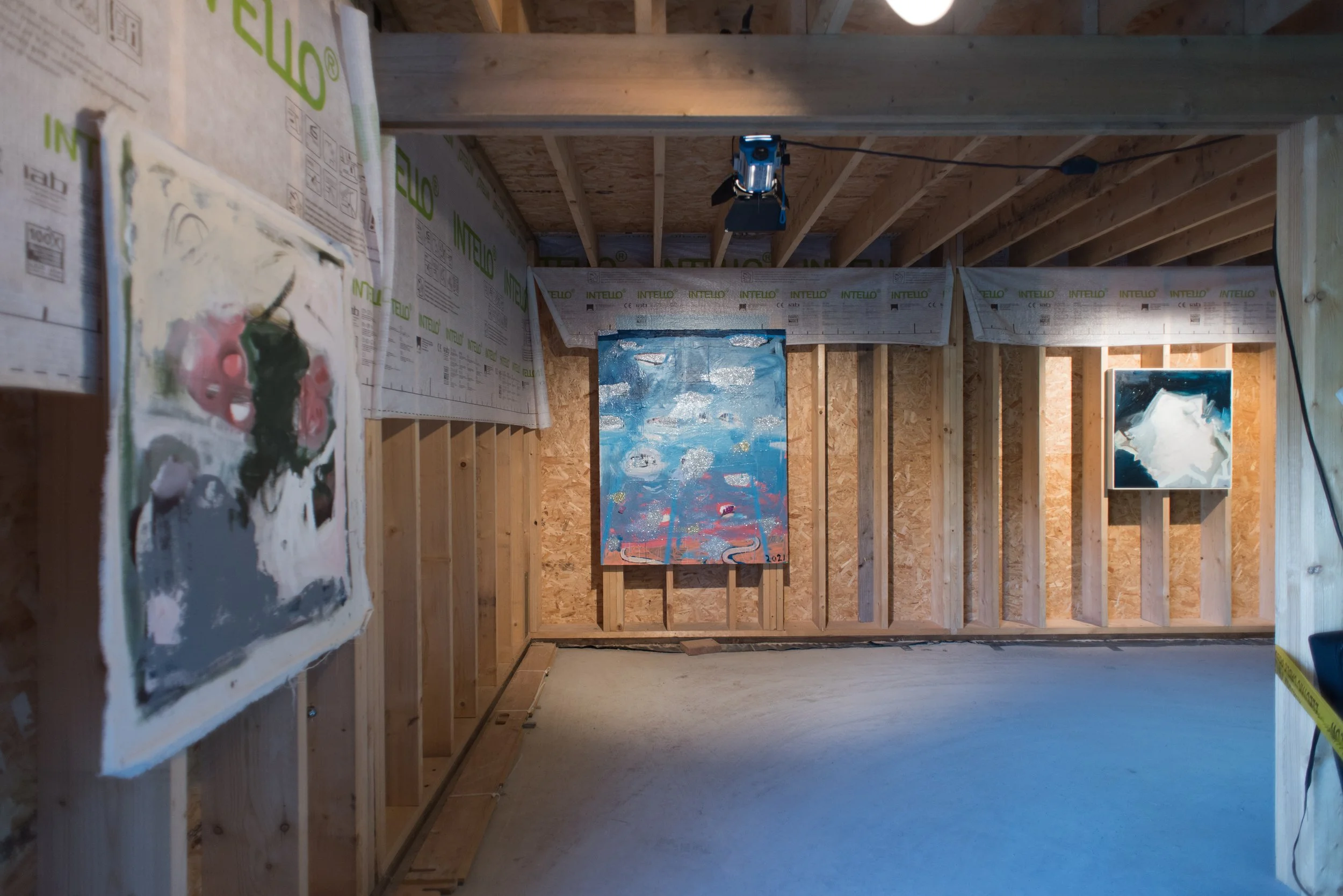Watch Them Dance
A place, a field, a studio, a home. The edge of the world. Six artists, painters, gathering, keeping time. At Autumn equinox when day and night are of equal time, when traditionally we ritually celebrated before the slow incline of winter.
We Can Dance takes place as the world strives to fall back into place, shaken as it was by months of restricted movement, uncertainty and loss. This exhibition of works represents a new phase.
As the world moves forward, we are invited to join this celebration of community and self-organisation, as the artists explore and experiment with exhibition making.
Like Bachelard’s ‘resting places for daydreaming’, the paintings in this space, in this landscape form a temporary monument to pasts as well as futures.
Paintings, like poems, can transcend eras and ‘instants are preserved’.
In surprise, years pass un-
naturally, in object-
ion to calendars.
Time not measure
of man, but what he may do,
with himself, in this hour’.
(From ‘The Travels of Imagination through time’, by John Wieners (1970))
The inner spaces of the imagination, the dreamscapes, the shapes of the landscapes around us and finally the great constellar space above us - and what we do as humans to understand the connections and the gaps between these spaces - is articulated by this gathering of paintings, a conversation that echoes in the studio|gallery|landspace, just a walk from the ocean.
West Cork is the location for We Can Dance, and Susan Montgomery’s studio. We experience this exhibition in her domestic and rural landscape, not just as viewers but as co-conspirators in a seasonal ritual. Ancient rhythms inspire her work and there is a turning and a beat in To hold. It is keeping time for us. We feel the vastness of the cosmos yet feel comforted. A healing is woven into the paint. In the matter of a 5 pointed star we experience a different energy, a brighter wider cosmology of potentiality.
It’s not so much that these artists are bursting forth from the restrictions of strange times, rather they are signalling a stepping out, like in a dance, from pandemic memories and from the weight of a gendered art history.
The act of an exhibition is as Susan Hiller says, ‘taking work past its point of completion’, as it becomes a mapping not just of inner worlds and concerns but of the shared and collective internalisations of our culture.
The act of this exhibition – self-organising to create community, upholding values of equality, of solidarity between painters, upends the potential alienation of the age. With echoes of the band Fugazi and the DIY movement, these artists are making something happen and are empowered in that making.
That connection to communal sites in Sinead Ni Mhaonaigh’s paintings are also suggestive of process; the artists’ process itself and its relation to life and history. In Untitled 2019, from her pink series, she puts a structure on the controlling chaos of the painters life, constructing worlds within worlds, while the more abstract Untitled 2019, tells us of the freedom after the fact.
The site of this exhibition – a studio - is a sacred space, much like how we think of Virginia Woolf’s a room of one’s own, but with this exhibition the sacred becomes communal for a duration. If “atmosphere" or "environment"' gets inside us and influences our very bodily workings (Teresa Brennan, 2004) this ritual-like event is a reverberation.
In the home scenes that Molly Douhit creates, we meet fragments of remembered places and atmospheres, drawing us in to witness a snapshot of those memories. The domestic scenes, with an almost polaroid quality, are reminiscent of film sets or film stills that are familiar yet elusive. Through the elusivity of her colour palette, the TBD bathroom could be a cutaway from Robert Altman’s Three Women, and Red Room, her grandparents room, with chenille bedspreads, like an imagined recollection from Cassevetes’ A Woman Under the Influence.
The shamanic undertones of Sarah O’Brien’s work elicits a curiosity about other worlds and takes us elsewhere. The alchemical markings engage us in a trance-like encounter where we feel watched from afar and there is a message to be deciphered from the midst of bodies and nature and archaic tongues.
Like delicate odes, to friendship and lovers, and to the simplest of gifts, made significant by intimacy, Chanelle Walsh’s evocative renderings of liminal flowers suggest feelings of love and loss. Here we find ourselves in sensory realm, placeless, with the provocative intimation that the essence of the social is how we are moved by one another.
The moving body, the root note of We Can Dance, ‘the twist of the hip’ on the canvas, is embodied in Aileen Murphy’s moving characters, shapes and gestures. Physical and psychological intensity express something wild and necessary. Amplified by vivid colours, something is stirring.
‘To keep dancing is a perseverance,’ much like painting. ((Browning 1998).
Sara O’Rourke 2021
from left, Mollie Douthit, Susan Montgomery, Sarah O’ Brien, Casey Walshe
from left, Susan Montgomery, Sarah O’Brien, Susan Montgomery
Mollie Douthit, Sarah O’Brien, Aileen Murphy (courtesy of the artist and Kevin Kavanagh Gallery)
from left, Mollie Douthit, Sinéad Ní Mhaonaigh
from left, Aileen Murphy (courtesy of artist and Kevin Kavanagh Gallery) Sarah O’Brien, Aileen Murphy.
from left: Offsite lecture on Sherkin island with Jesse Presley Jones for TUD BAVA Sherkin students, Meadowsweet foraged for Opening drinks, dancing by bonfire, Offsite performance on the Long Strand by Aoife Desmond and Macha Shewolf, Crew: Sarah O’Brien, Susan Montgomery, Casey Walshe, Sara O’Rourke, Jesse Presley Jones, apples gathered from site used for cakes with tea for visitors, performance on site with Eilis Collins, performance on the Long Strand.















